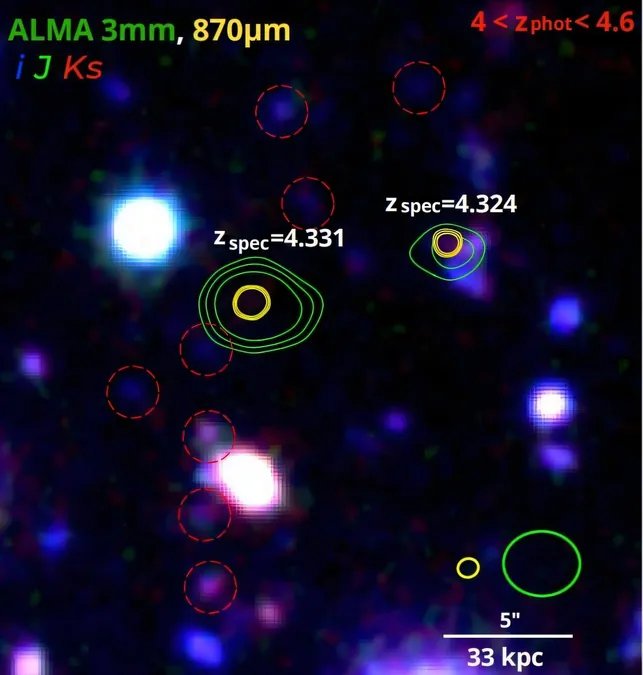
Breakthrough Discovery: Astronomers Find Two Mysterious Dark Galaxies in Newly Identified Galaxy Group
2025-01-20
Author: Jacques
Introduction
In a stunning advancement in astronomical research, an international team of astronomers has unveiled a new compact galaxy group named CGG-z4, using the powerful Atacama Large Millimeter/submillimeter Array (ALMA). This groundbreaking discovery highlights the presence of two optically dark, star-forming galaxies, providing fresh insight into the evolution of the universe.
Importance of Galaxy Groups
Galaxy groups, which typically contain up to 50 galaxies, are critical for astronomers studying massive galaxy growth and development. These structures, especially those that are denser, serve as prime candidates for understanding the cosmos's expansion and the formation of galaxies after the Big Bang.
Research Overview
The discovery was spearheaded by Malte Brinch and his team from the Technical University of Denmark, who pinpointed CGG-z4 in the Cosmic Evolution Survey (COSMOS) field — a rich area for cosmic research. The findings, detailed in a research paper on arXiv, present a significant step forward in our understanding of galaxy evolution.
Key Findings
Dr. Brinch's team identified CGG-z4 as an intriguing sky overdensity of galaxies at a redshift of about 4.3. Their meticulous observations revealed a total of 13 galaxies within a compact region of just 13 by 31 arcseconds, further underscoring the group's dense nature.
Mass and Star Formation Rates
In terms of mass, CGG-z4 boasts about 100 billion solar masses in stellar mass and an impressive dark matter halo estimated to exceed one trillion solar masses. The galaxy group showcases a notable star-formation rate, clocking in at approximately 2,837 solar masses per year.
Unique Features of CGG-z4
What sets CGG-z4 apart from other galaxy groups is the presence of two optically dark galaxies, designated CGG-z4.a and CGG-z4.b. These galaxies, although lacking in visible light, possess enormous reserves of gas, demonstrate significant star formation, and feature short gas depletion times of around 100 million years. This indicates a high rate of star formation efficiency, hinting at an impending quenching phase that could see them double in mass before transitioning to a more dormant state at a redshift close to 4.0.
Future Projections
Researchers surmise that CGG-z4 is on a trajectory to evolve into a massive galaxy cluster similar to the Virgo or Coma clusters over the next 10 billion years. Their simulations suggest that CGG-z4 could form a cluster exceeding 10^14 solar masses, with the two dark galaxies potentially serving as Brightest Cluster Galaxies (BCGs).
Conclusion
To fully understand the membership and dynamics of CGG-z4, the astronomers emphasize the necessity for follow-up observations. This discovery not only enriches our knowledge of galactic structures but also opens new avenues for understanding the complex processes behind galaxy formation and evolution in the early universe. Stay tuned as we continue to monitor this exciting development in galactic research!









 Brasil (PT)
Brasil (PT)
 Canada (EN)
Canada (EN)
 Chile (ES)
Chile (ES)
 Česko (CS)
Česko (CS)
 대한민국 (KO)
대한민국 (KO)
 España (ES)
España (ES)
 France (FR)
France (FR)
 Hong Kong (EN)
Hong Kong (EN)
 Italia (IT)
Italia (IT)
 日本 (JA)
日本 (JA)
 Magyarország (HU)
Magyarország (HU)
 Norge (NO)
Norge (NO)
 Polska (PL)
Polska (PL)
 Schweiz (DE)
Schweiz (DE)
 Singapore (EN)
Singapore (EN)
 Sverige (SV)
Sverige (SV)
 Suomi (FI)
Suomi (FI)
 Türkiye (TR)
Türkiye (TR)
 الإمارات العربية المتحدة (AR)
الإمارات العربية المتحدة (AR)